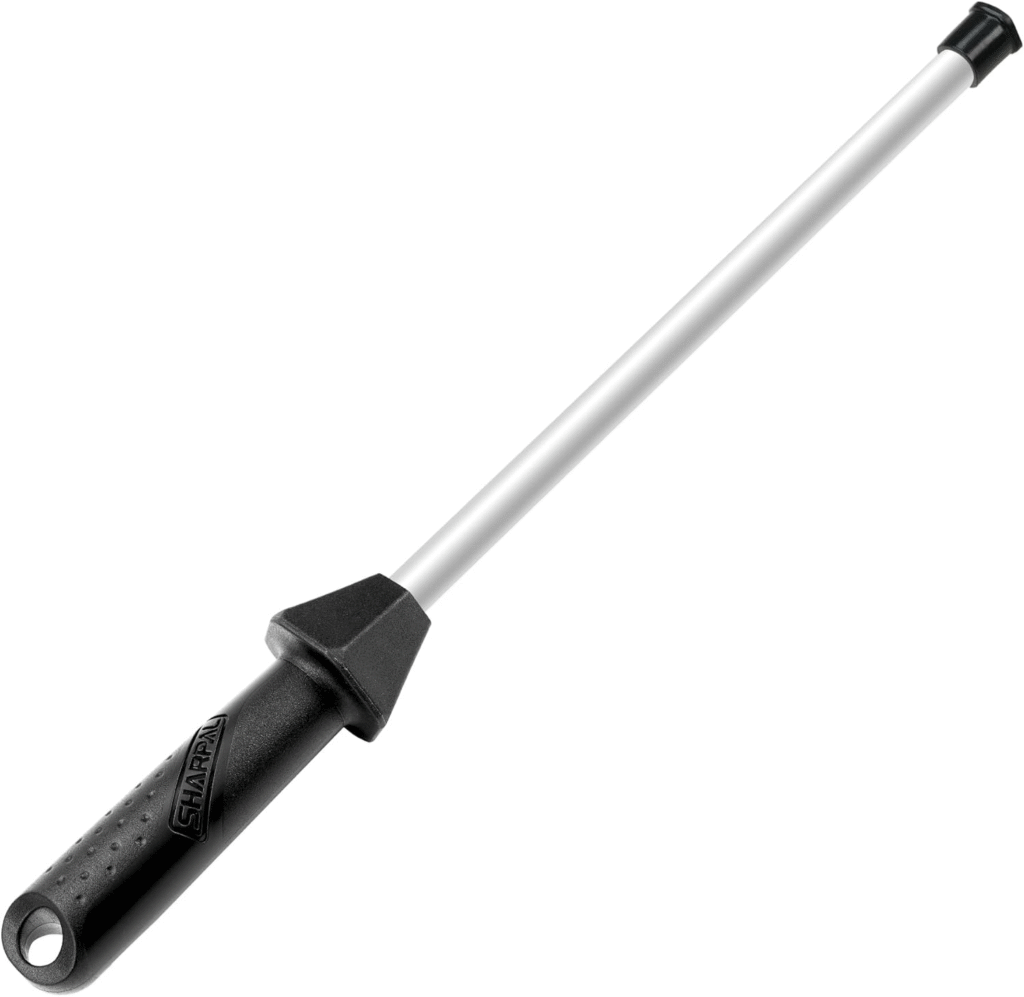
If you want your knives to feel like new every time you cook, a good honing rod is indispensable. The SHARPAL 118H Ceramic Honing Rod stands out by pairing a fine 3000‑grit ceramic with built‑in 20° angle guides, a hexagonal hand guard that won’t roll off your counter, and a protective rubber tip to help prevent chips if it’s dropped. For home cooks and pros who prefer a polished edge and easy, repeatable technique, it’s a strong buy.
See it on Amazon:
- SHARPAL 118H Ceramic Honing Rod
- ceramic knife sharpening rod with 20° angle guides
- professional ceramic honing steel, 3000‑grit
- SHARPAL 118H sharpening stick
What makes the SHARPAL 118H different
- Consistent, accurate angle: Integrated 20° angle guides help you hit a true 20° per side (40° inclusive), ideal for most Western kitchen knives.
- Hard, fine ceramic: Ceramic is harder than steel, and the 3000‑grit surface refines and polishes the edge for push‑cut performance.
- Safer, smarter build: A hexagonal hand guard stops the rod from rolling; a removable rubber cap cushions the tip and protects your countertop.
- Built to last: Non‑toxic, odorless, and rust‑free ceramic with excellent wear resistance.
- Backed support: 3 years of commitment and after‑sale service from SHARPAL (HQ in California, with branches in Germany and Australia).
Specs and features at a glance
- Grit: 3000 (fine)
- Angle aid: Built‑in 20° guides
- Guard: Hexagonal hand guard (anti‑roll)
- Tip: Removable rubber cap to protect surfaces and help minimize chipping
- Material: High‑performance ceramic (harder than steel), non‑toxic, odorless, rust‑free
- Use case: Daily/weekly edge maintenance and polishing on most kitchen knives
Why choose ceramic over steel (or diamond)?
- Ceramic vs steel honing rods: Traditional “steel” rods primarily realign a fatigued edge; fine ceramic both realigns and lightly abrades to actually refine the apex. Ceramic is especially helpful on harder blades that a plain steel can’t effectively maintain.
- Ceramic vs diamond rods: Diamond rods are aggressive and excel at repairing dull edges quickly, but they remove more metal and can leave a coarser finish. The SHARPAL 118H’s 3000‑grit ceramic leaves a cleaner, longer‑lasting, polished edge that glides through produce.
Real‑world performance: What to expect
- For maintenance, not major repairs: The 3000‑grit ceramic is perfect for touch‑ups and maintaining a sharp edge between full sharpenings. If your knife is nicked or very dull, use stones or a lower‑grit diamond solution first.
- Excellent on hard steels: Ceramic’s hardness lets it refine high‑hardness stainless and carbon steels that a basic steel rod won’t touch effectively.
- Polished edge feel: Expect clean slicing on onions, herbs, proteins, and fruit. If you prefer a “toothier” bite for crusty bread or tomatoes, you can add a micro‑bevel with a couple of light passes at a slightly higher angle after honing, or use a lower‑grit option occasionally.
Standout design details
- 20° angle guides: The built‑in guides make repeatable technique easy—especially useful for beginners. Note: Many Japanese knives are intended for 12–15° per side; you can still use this rod by ignoring the guide and holding a shallower angle.
- Hexagonal hand guard: Doubles as an anti‑roll feature so the rod stays put on the counter, and it improves grip and safety.
- Protective rubber tip: Helps protect the rod and your countertop during vertical honing and adds a measure of drop protection. Ceramic is still brittle—use care and avoid hard impacts.
How to use the SHARPAL 118H for best results
- Clean the blade. Wipe off food residue so you’re not grinding debris into the edge.
- Set the angle. Place the heel near the top of the rod and align to the 20° guide (or your preferred angle).
- Light, even strokes. Draw the blade down and toward you from heel to tip, maintaining angle. Use feather‑light pressure—let the ceramic do the work.
- Alternate sides. 5–10 strokes per side is plenty for a touch‑up.
- Test the edge. Slice paper or a tomato; if needed, add a couple more light passes.
- Clean the rod. Wipe with a damp cloth. If grey “swarf” builds up, use a soft abrasive eraser or mild cleanser to refresh the ceramic.
Maintenance tips
- Don’t over‑pressure. Leaning too hard can glaze the surface, create micro‑burrs, or risk chipping the ceramic.
- Keep it clean. Metal residue reduces effectiveness; periodic cleaning restores bite.
- Store safely. Use the rubber tip, hang it securely, or keep it in a protective sleeve/drawer insert to avoid knocks.
- Not for serrations. Full‑size ceramic rods aren’t ideal for serrated edges; use a tapered sharpener for that job.
Who this honing rod is for
- Home cooks who want sharp, consistent edges without fuss
- Pros who like a polished 3000‑grit finish for smooth slicing
- Owners of mid‑ to high‑hardness knives (stainless or carbon) who want a maintenance tool that actually refines the edge
- Beginners who benefit from built‑in 20° angle guides
Who might want something else
- Very dull or damaged knives: Start with a coarser stone or diamond rod before finishing with the SHARPAL 118H.
- Dedicated Japanese‑profile users (12–15° per side): You can still use this rod at a shallower angle, but a matching angle guide or stones may suit you better for true single‑bevel or ultra‑thin geometry.
- Serrated knives: Use a dedicated serration tool instead.
Pros
- 3000‑grit ceramic polishes and refines for razor‑sharp results
- Built‑in 20° angle guides make consistency easy
- Hexagonal hand guard prevents rolling and boosts safety
- Removable rubber tip helps protect the rod and your surfaces
- Non‑toxic, odorless, rust‑free ceramic with high wear resistance
- 3‑year commitment and strong after‑sale support
Cons
- Ceramic can chip if dropped or struck—handle with care
- 20° guide is tailored to Western angles; Japanese knives may need a manual angle
- Not a substitute for coarse sharpening when blades are very dull or chipped
Comparison: Ceramic honing rod vs whetstones vs pull‑through sharpeners
- Whetstones: Best for full sharpening and geometry control; steeper learning curve and more time. The SHARPAL 118H is faster for routine maintenance.
- Pull‑through sharpeners: Quick but often remove a lot of metal and can leave a rougher edge. Ceramic honing preserves more steel and finishes cleaner.
- Steel rods: Great for quick realignment on softer steels; less effective for hard steels and don’t polish like ceramic.
FAQs
- Can I use it daily? Yes—light daily or weekly touches keep edges consistent and extend time between full sharpenings.
- Will it fix chips? No. This is a fine maintenance tool; use coarser abrasives first for repairs.
- Safe for stainless and carbon steel? Yes. Ceramic is inert and rust‑free, suitable for both.
- How do I clean the ceramic? Wipe with a damp cloth after use; for stubborn swarf, use a rubber “abrasive” eraser or a mild cream cleanser, then rinse and dry.
- Is the 20° angle fixed? The guides are there to help, but you can choose any angle by adjusting your wrist and ignoring the guide.
Where to buy
- SHARPAL 118H Ceramic Honing Rod
- ceramic knife sharpening rod with 20° angle guides
- professional ceramic honing steel, 3000‑grit
- SHARPAL 118H sharpening stick
Verdict: A polished performer that makes sharp easier
For most home kitchens and many pro setups, the SHARPAL 118H strikes a sweet balance: it’s gentle on your knives, hard enough to maintain high‑HRC blades, and refined enough to deliver a clean, polished edge without a full sharpening session. Add the 20° angle guides, anti‑roll hand guard, and protective rubber cap, and you’ve got a maintenance tool that’s both capable and confidence‑inspiring.
Amazon Affiliate Disclosure
As an Amazon Associate, I earn from qualifying purchases. If you purchase through the links above, I may receive a small commission at no extra cost to you. Prices and availability are subject to change.

Hi, I’m Candace Wafford, a travel and food blogger based in Lexington, Kentucky. As a corporate traveler, I’ve had the chance to explore a lot of places, but now I’m on a mission to travel full-time. My goal? To figure out how to take my cat along for the adventure! Here at destinationdorworth.com, I share my experiences and tips on outdoor activities, travel, and of course, the best food spots I come across. I hope my blog inspires you to explore more and eat well on your journeys!
